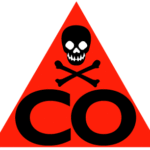Protecting Workers from Carbon Monoxide Poisoning

Along with all of the other hazards posed by winter weather, such as extreme cold, workers may also be at risk of carbon monoxide poisoning. Exposure to this danger is especially likely if they use portable heaters—or improvise in an attempt to get warm. (Click here for the portable heater requirements under the OHS laws across Canada.)
For example, a 21-year-old worker in New York died from carbon monoxide poisoning after starting a lawn mower in the back of a truck for warmth. He and his younger cousin were cold after spending several hours doing landscape work outside. They were found unresponsive in the truck with the lawnmower still running.
The Dangers of CO
As an Alberta safety bulletin explains, carbon monoxide is a colourless, odourless gas, which is what makes it so deadly. Workers may not even realize they’ve been exposed to this deadly gas until it’s too late.
Some of the potential sources of carbon monoxide in the workplace include emissions from:
- Internal combustion engines
- Kilns
- Furnaces and boilers
- Welding
- Moulding of plastics
- Forging, ceramic, petroleum, steel and waste management industries
- Space heaters and improperly adjusted oil or gas burners
- Fires and explosions
- Cigarette smoking.
Depending on the level of exposure to carbon monoxide, workers can suffer from:
- Mild to severe headaches
- Weakness, dizziness, nausea and fainting
- An increased or irregular heart beat
- Loss of consciousness
- Death.
Exposure to carbon monoxide is especially hazardous for older workers, pregnant workers, workers with certain health conditions, such as anaemia and lung disease, and workers who work in high altitudes and high temperatures.
How to Protect Workers
The best way to protect workers is to keep them from being exposed to carbon monoxide (CO). US OSHA has a fact sheet that recommends that employers do the following to protect workers from CO:
- Install an effective ventilation system that will remove CO from work areas.
- Maintain equipment and appliances (such as water heaters, space heaters, cooking ranges) that can produce CO in good working order to promote their safe operation and to reduce CO formation.
- Consider switching from gasoline-powered equipment to equipment powered by electricity, batteries or compressed air if it can be used safely.
- Prohibit the use of gasoline-powered engines or tools in poorly ventilated areas.
- Provide personal CO monitors with audible alarms if potential exposure to CO exists.
- Test air regularly in areas where CO may be present, including confined spaces.
- Install CO monitors with audible alarms.
- Educate workers about the sources and conditions that may result in CO poisoning as well as the symptoms and control of CO exposure.
- If workers are working in confined spaces where the presence of CO is suspected, ensure that workers test for oxygen sufficiency before entering.
And workers can do the following to reduce the chances of CO poisoning in the workplace:
- Report any situation to your employer that might cause CO to accumulate.
- Be alert to ventilation problems—especially in enclosed areas where gases of burning fuels may be released.
- Report promptly complaints of dizziness, drowsiness or nausea.
- Avoid overexertion if you suspect CO poisoning and leave the contaminated area.
- Tell your doctor that you may have been exposed to CO if you get sick.
- Avoid the use of gas-powered engines, such as those in powered washers as well as heaters and forklifts, while working in enclosed spaces.
For additional carbon monoxide tips, see this pamphlet from WorkSafeNB. And for training resources on carbon monoxide, such as safety talks for workers, go to SafetySmart.com.